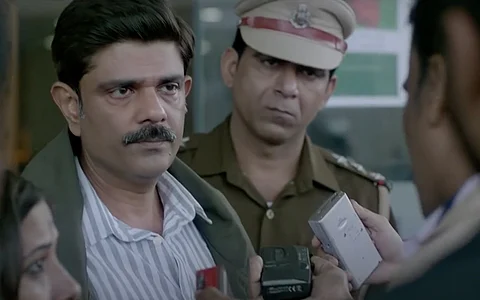
- In-Depth Stories
- Web Stories
- Reviews
- News
- FC Lists
- Interviews
- Features
- FC SpecialsFC Specials

Director: Sachin Pathak
Writer: Siddharth Mishra
Cast: Amit Sial, Aksha Pardasany, Anshumaan Pushkar
Producer: Ajay G Rai
When national security is at stake, so is an idea of masculinity. To win the war against terrorism, therefore, must involve some oomph, a lift of swagger, establishing again, who really is in charge. It is why the latest crop of male saviours — Sartaj Singh in Sacred Games, Hathi Ram Chaudhuri in Paatal Lok, Srikant Tiwari in The Family Man — broken men, tottering precariously on the verge of being a sympathetic loser, is such an exciting innovation of the terrorism genre; cleaving any semblance of aspirational masculinity from the role.
Kathmandu Connection piggy-backs on this idea but pushes it further. What if the person trying to save the country, so to speak, isn't even likeable? Here it is ACP Samarth Kaushik (Amit Sial), who is first seen performing an encounter killing in Delhi, 1990, giving him an instant DCP promotion. It's in black and white to establish that this scene is a flashback. But later on in the series, when timelines keep jerking to flashbacks, the monochrome tint is no longer used — it's all colour now.
Where the show — 6 episodes, 35 minutes each — appears inventive is in muddying the moral compass of the "saviour". In the first encounter, we clearly see Samarth shooting an innocent man dead. It is brushed under the rug, but is brought up later while stockpiling evidence against him. He's a boozard, divorced, and has zero charm, charisma, or even, as we see, competence. The love angle given to him — with the journalist Shivani Bhatnagar (Aksha Pardasany) with 80s ribbon-tied hair — is so loosely, unconvincingly told, it felt like a farce the whole time, waiting to unravel something sinister under it. The main subversion here is thus creating, on the surface at least, a saviour we don't want to root for. While this could have made for an interesting stand-off with the "villain" by putting them on equal moral footing, here the "villain" he is pitted against — Om Prakash Sharma (Anshumaan Pushkar) — is listless and lacking in menace or meat. So this ingenuity is tossed to the bin.
The makers try to weave so inextricable a web at the very beginning, with four seemingly unrelated threads running parallelly — DCP Samarth Kaushik searching for a kidnapper, a CBI investigator searching for clues of someone associated with the 1993 Mumbai bomb blasts, a TV journalist who gets anonymous yearning calls, and Om Prakash Sharma building his empire in Kathmandu. Soon all these threads are all joined with messy ease. This creates a world so insular and specific that all a journalist does is report on the most mundane details relevant to the plot, but irrelevant to the country or even the news cycle. Since the show is set in the 1990s, the makers decide to use television news for what would be a Whatsapp message today, just so the characters are abreast of what is happening to the others.

The rest is a familiar mess. The show trots between UP, Delhi, and briefly Kathmandu and Hong Kong. But there is no sense of place, as if it is enough to have a title card of a city, followed by wide-shots of tourist attractions, and indoor decor with culturally appropriate curios. The immersive Kashmir of Family Man was a masterclass in using space to prop the story, and not just use space as a prop for the story. The titular Kathmandu Connection is so thinly sketched and so breezy in its appearance I wondered what the point of naming the show after it was. Kathmandu barely makes it in small sketches across two episodes.
But the more pressing issue is that for a thriller, the makers were unable to craft a single tense moment. The verbose altercations, the chilly interactions where one of them doesn't know who the other is, the build up to shootout scenes — none of it creates even a semblance of intrigue. The scenes just play out without any tension rooting and propelling the narrative — a limp listlessness. This is certainly because there is no character you would rather have alive. It is also perhaps because there is a technical craft involved in constructing tension — ample close-ups, shaky movements, a music score on the verge of erupting.

Take for example the scene where two people are given an assignment to gun down Om Prakash, who is hosting a conference. The two gunmen go as participants to the conference, and there, mid-way through Om Prakash's speech, they get up, and point their gun at him for a good five seconds, not shooting, not even performing shooting, just standing there. This gives Om Prakash enough time to get the lights switched off and have his life saved. It's patently silly, with lethargic treatment of action and plotting; a thriller with no thrill.